Technically, you can think of Search Intent In SEO as what users actually want when they search for a given keyword. For example, we can say someone searching for the “best email marketing tool” probably doesn’t want to read an in-depth review of one single tool. Instead, they want to see a comparison.
Especially, a comparison of an array of different tools. As a result, that’s the kind of content that ranks on the first page of Google for that keyword: product comparisons. Meaning, if your content doesn’t fulfill the search intent for a given keyword, it’s very unlikely to rank well. Even if you do everything else right.
Search intent is just that — very important! The latest version of Google’s Search Quality Raters Guidelines includes the word “intent” 408 times. Clearly, Google is paying a lot of attention to search intent. So, not sure how to tackle it, yet? Well, worry no more! This guide is there to your rescue.
What Is Search Intent In SEO?
Also known as Audience Intent, User Intent, or keyword Intent, Search Intent is what defines the sole purpose of a user’s search capacity. Following this, there are many algorithm adjustments to the likes of Google Hummingbird, Google RankBrain, and others. Google automatically interprets search intent and shows users results that align with it.
The search engine often uses rich snippet results like the Answer Box and Knowledge Panel. Obviously, because people’s queries reflect where they are in the conversion funnel. Thus, understanding search intent can greatly help. More so, as you create effective content that targets potential customers.
So, with that in mind, why is Search Intent important to SEO? Usually, how well you understand the search intent impacts your ability to rank. As well as whether your readers are satisfied with your page’s content or not. On that note, Google even goes into detail about intent in their Quality Evaluator Guidelines too — something that needs full attention.
Of course, you’ll be so frustrated if you want to learn about how motorcycles work, but all your search results try to sell you one instead. That experience is what you’re trying to prevent. Particularly, by adding user intent into your SEO strategy. A thorough understanding of search intent can greatly help you in so many ways.
A good search intent helps you:
- Do more effective keyword research
- Create content that answers most of your web user questions
- Target search terms that align with your business’s and your audience’s needs
- Structure pages in a way that’s friendly to both users and search engines
- Optimize for content that is more valuable and relevant to users
- Rank higher by creating content that search engines understand
While they often overlap, you can break search intent down into four basic categories.
The four main search intent category types are:
- Navigational Intent: Trying to find something (e.g., “Subaru website”)
- Informational Intent: Trying to learn more about something (e.g., “What’s a good car?”)
- Transactional Intent: Trying to complete a specific action (e.g., “buy Subaru Forester”)
- Commercial Intent: Trying to learn more before making a purchase decision (e.g. “Subaru vs. Nissan”)
According to Semrush, these can roughly align with your audience’s buyer journey. Normally, web users will probably use informational keywords when first getting to know you.
Meaning, when they’re warming up to you, and considering a purchase, they might start using commercial keywords. And, when they’re ready to convert, that’s where transactional keywords come in. That said, let’s now look at each type of search intent in detail. How they’re relevant, and how to target those keywords.
A. Navigational Search Intent
Navigational Search Intent means that the user wants to find a specific page, domain, or physical address. It overlaps with Google’s “visit” and “website” user intents and includes local search. The key to understanding navigational intent is that users already know what they’re trying to find.
So, if you’re targeting a keyword like this, you probably don’t need to sell them on something new. For their part, Google’s mission is to deliver it to them in the most efficient way possible. To do so, Google uses Search Engine Results Page (SERP) features like knowledge panels or local packs.
For example, the knowledge panel provides more context, including a link to Google Maps and a phone number. Forthwith, for a search phrase like Web Tech Experts, make sure your local listings are correct and up-to-date. Additionally, ensure your location and contact info are easily accessible on your site.
Navigational keywords are all about ensuring your current or future customers can find you when they need you most. Often, they’re branded. They can also give you insight into how users interact with or think about your brand.
For example, if the vast majority of queries are for a specific product page, it’s probably popular among your audience. Conversely, if you see a sudden spike in, say, customer service searches, it might be worth investigating why.
B. Informational Search Intent
Informational Search Intent means that the user wants to learn something. Often, users phrase these searches as questions and use words like who, what, where, why, and how. Questions asked can range from extremely specific (“how old is Madonna?”) to broad or complex (“critical analysis of The Illiad”).
For more specific queries with concrete answers, Google will often use SERP features to answer the question so users won’t have to leave the page. Informational queries make up the vast majority of searches performed on Google. Queries cover a broad topic for which there may be thousands of relevant results. So, if you want visibility, you can’t afford to ignore them.
That said, they can still be a valuable opportunity to grow your business. Providing your audience with informational or educational content is a great way to build trust in your expertise. In addition to increasing your visibility, you can use this content to target new customer leads and target audiences that you can easily convert later on.
C. Transactional Search Intent
Transactional Search Intent means users want to do something specific, either in person or using their device. Despite what the name implies, this isn’t restricted just to purchases. A user doing a transactional search might also want to complete an email newsletter signup, create a form submission, visit a store, or make a phone call.
Some transactional queries are direct, making what the user is trying to do obvious. Other times, it’s unclear whether a user’s intent was transactional, commercial, or informational. More often, this happens when the search term is the name of a specific product. This is where search results in SERP features come in handy.
In this case, the search results will include various SERP features to help research that product or complete their purchase. The knowledge panel contains transactional content—comparing different outlet prices. And commercial content — with basic product info, user reviews, ratings, questions, etc.
At all costs, transactional keywords are your money-makers. These are the keywords your future customers use when they’re ready to convert — whatever conversion means for you. Seize your opportunities by targeting transactional keywords. Optimize product landing pages for an easy purchasing process.
D. Commercial Search Intent
Generally, Commercial Search Intent is like a hybrid of informational and transactional. In other words, these are the keywords your audience uses when they’re doing their research before making a purchase decision. For instance, let’s say, for example, you’ve decided to buy a new phone. But again, you’re not sure if you want to spring for a new iPhone.
Or rather, a Samsung Galaxy. And you go on to search for “iPhone 13 vs Samsung s21:” By doing so, for a search like this, the SERP feature compares both products. So that users can easily make their purchase decision. If you expand it, you can even find more relevant details. Important to realize, product comparisons aren’t the only type of commercial search.
A web user might also look for:
- Reviews from users or authoritative sources
- Technical specifications or other details
- Brand agnostic recommendations (e.g., “best phones 2022”)
- Free trials or product demonstrations
- Other pages that help them learn about a product or service
Keep in mind, commercial keywords are all about showing your audience what you have to offer. And then, giving them the information they need to convert. Therefore, you should make your audience find and use this information.
Furthermore, the more likely it allows them to move forward. With your unique keywords, you’re trying to stay in connection with your lead users at all times. In particular, during the most important site user stage — the buyers’ journey.
The Main Search Intent Targeting SEO Benefits
People search the Internet for a variety of purposes, ranging from accomplishing a quick task to researching a topic in depth. A search may be part of a long-term project, such as a home remodel or vacation planning.
In a real sense, a search may be done when someone is bored and looking for entertainment. Such as a search for [funny videos]. A search may be a single question asked during a critical moment in a person’s life.
Such as what are the symptoms of a heart attack. Notably, the World Wide Web (WWW) is a vast collection of online information and content. Search engines provide a powerful way to explore this online universe with many ways to search.
Below are the most common web search methods:
- people may type words into a search box in a browser,
- speak to a mobile phone or assistant device,
- use search engine autocomplete features, etc.
Most Search Engines exist to help people find what they are looking for. To do that, search engines must do quite a heavy lifting. They must provide a diverse set of helpful, high-quality search results, presented in the most helpful order. Different types of searches need very different types of search results.
By all means, medical search results should be high quality, authoritative, and trustworthy. Search results for “cute baby animal pictures” should be adorable. Search results for a specific site or page should have that desired top result.
Learn More: What Are Search Engines? 10 Best Picks For Webmasters
Searches that have many possible meanings or involve many perspectives need a diverse set of results. More so, to reflect the natural diversity of meanings and points of view.
The majority of people all over the world use search engines. Therefore, diversity in search results is essential to satisfy their diversity. For example, searches about groups of people should return helpful results that represent a diversity of demographic backgrounds and cultures.
Last but not least, search results should always gear themselves toward helping their web users. Equally important, they should provide authoritative and trustworthy information. Otherwise, they should not lead people astray with content.
Relevant Topic: Search Engine Marketing | What Is It & How Is It Effectively Done?
Precisely, they should also allow people to find what they’re looking for fast, and easily. But, not to surprise the web users! With unpleasant, upsetting, offensive, or disturbing content. Harmful, hateful, violent, or sexually explicit search results are only appropriate if the person phrased their search.
More so, in a way that makes it clear that they are looking for this type of content. And, there’s no other reasonable interpretation of the words used in their search. For this and other reasons, Search Intent is a massive part of how Semantic SEO delivers relevant search results to users.
Better intent optimization can drive more relevant and qualified traffic to your website. This could mean improved landing page conversion rates and a host of other content-type benefits.
Some of the benefits of such content types include:
- Reduced bounce rates: People get what they want, so they stay on your pages.
- More page views: Meeting a user’s intent makes them more likely to engage with the rest of your website.
- More featured snippets: Having your content selected for Google’s rich snippets can significantly benefit you. It allows your pages to rank in position 0 above the first search result.
- Wider audience reach: Google is smart enough to interpret multiple queries with the same topic and intent. That means it will show your optimized page for a lot more questions.
In summary, the search intent SEO benefits include more pageviews, answer boxes, fewer bounce rates, a wider audience reach, more conversion rates on transaction pages, etc.
And now, as you can see, these benefits are what make Search Intent Optimization so robust. If you’ll do it right, you’ll see a larger number of audiences falling back to your site. You’ll also get more qualified traffic and better engagement metrics for your content.
How To Optimize For Each Search Intent Type
First of all, make sure your site’s structure is organized and easy to navigate to target navigational keywords. Each section of your site should be clearly labeled, with page titles, tags, headers, and descriptions that tell the user what information they’ll find there. With such great flow, you’ll even win your lead users to come back.
On one hand, make sure each product or service you offer has a dedicated effect or landing page containing all the most relevant information. Optimize each page using the appropriate brand and product names. Add other applicable terms (e.g., the type of product or the problem it might solve).
Learn More: How Semrush Can Help You Analyze Your Users Intent In Search
On the other hand, optimize your URLs to be descriptive and easy to read. To target keywords with informational intent, pay close attention to the information users are searching for. Write your content to provide it as clearly as possible. Below are other optimization features to consider in your SEO marketing.
1. Utilize SERP Feature To Target Navigational Data
For example, a “how-to” query typically looks for a structured process. Below is the SERP feature for the term “how to start writing a book:” Notice how the featured content appears as an ordered list, with clear, numbered steps.
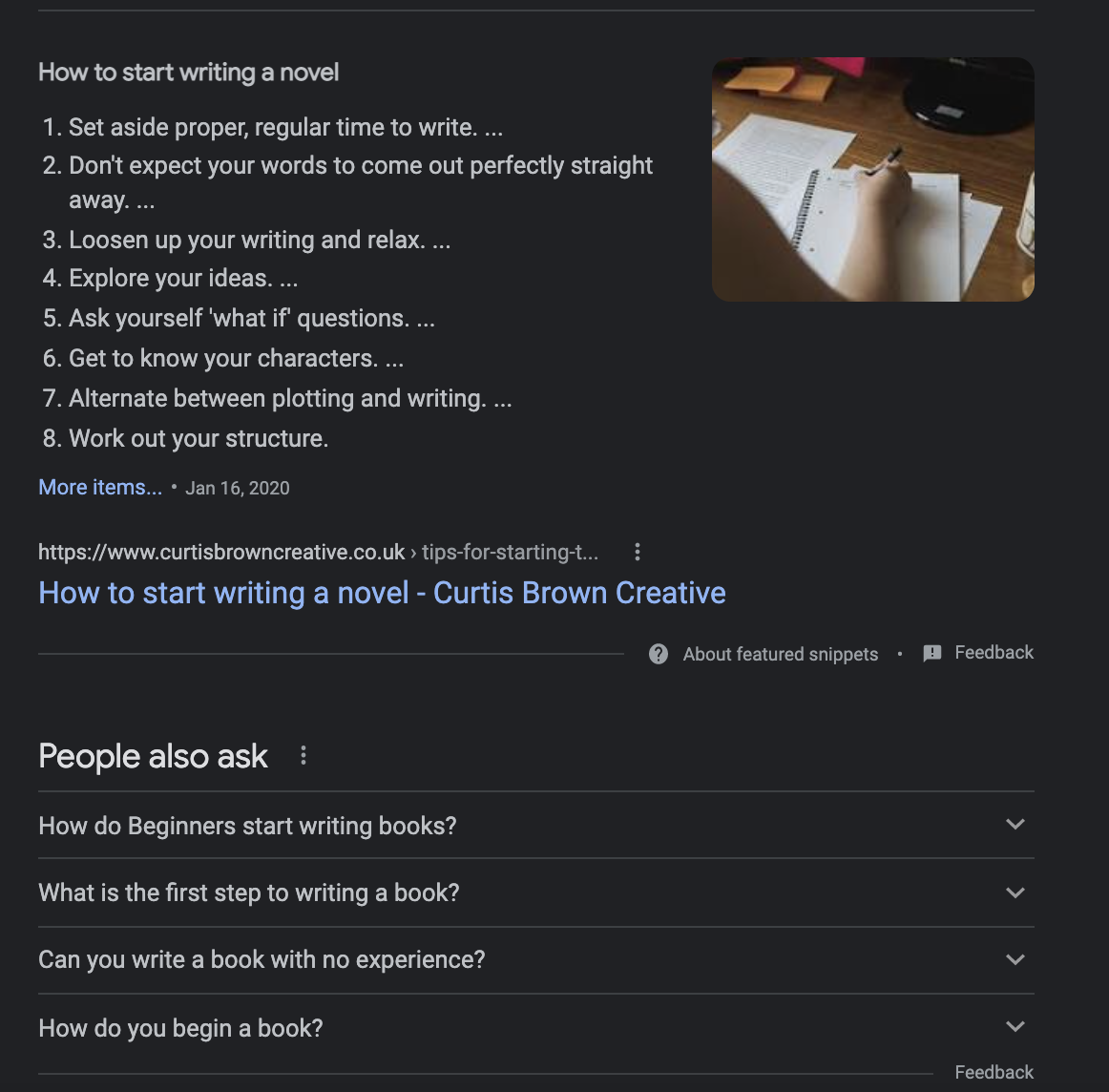
If you click through to the source, you’ll notice that each numbered step is a subheader with detailed information below it. Google used these headers to assemble the rich snippet.

If you wanted to write your own “How To” blog post, it would look something like this:
<H1> How To Make a Sandwich</H1>
Here, you'd write an introduction. With the H1, you've established the question your post will answer.
<H2> Step 1: Choose Your Bread</H2>
<p>In the body of your text, expand on each step listed in the adjacent H2. Include details about the process and other important information to consider.</p>
Whatever the topic or question type, make sure you’re structuring it properly if you’re writing informational content. Wherever you can, include all the essential information.
Such as steps or answers to questions, in your page title, description, and headers. Specifically, you can then use other text elements to complement this further. Text elements like lists, charts, and graphics. Perse, in order to present your information more reader-friendly.
2. Start Targeting Transactional Keywords
Targeting transactional keywords means knowing what conversion means for you (Do you want them to register? Buy something?) Providing all the most relevant information in the most user-friendly way you can. As well as making the conversion process as straightforward as you can.
You want this process to be seamless, whether they’re starting on your site or Google. To do this, make sure all relevant pages are easy to find and contain all necessary information for users to complete the desired action. First, make sure you’re directing users to a page designed for this purpose.
Such a page should have:
- Page Title, Description, and Headers that include your keywords
- Definitely, a clear indication of the purpose of your page
- A Clear Call To Action (CTA) that’s easy for users to spot and understand
- A Clear Design that helps users find the info they need quickly and complete their conversion easily
- Optimized text that engages and simplifies the decision process by providing the most critical information
Finally, whether it’s a product or a landing page, you’ll need to use structured data. Especially, to help Google better understand what’s on the page. So that it can deliver it to users when they’re ready to convert. Learn more about using structured data through our Technical SEO, Local SEO, and International SEO guides in detail.
3. Start Optimizing For Commercial Intent
Like informational keywords, you want to target commercial keywords; you need to know what the user is asking for. Next, structure your page well so that users can find the answer as efficiently as possible.
As an example, below is how Apple’s official website compares the iPhone 13 with the iPhone 13 Pro to users:
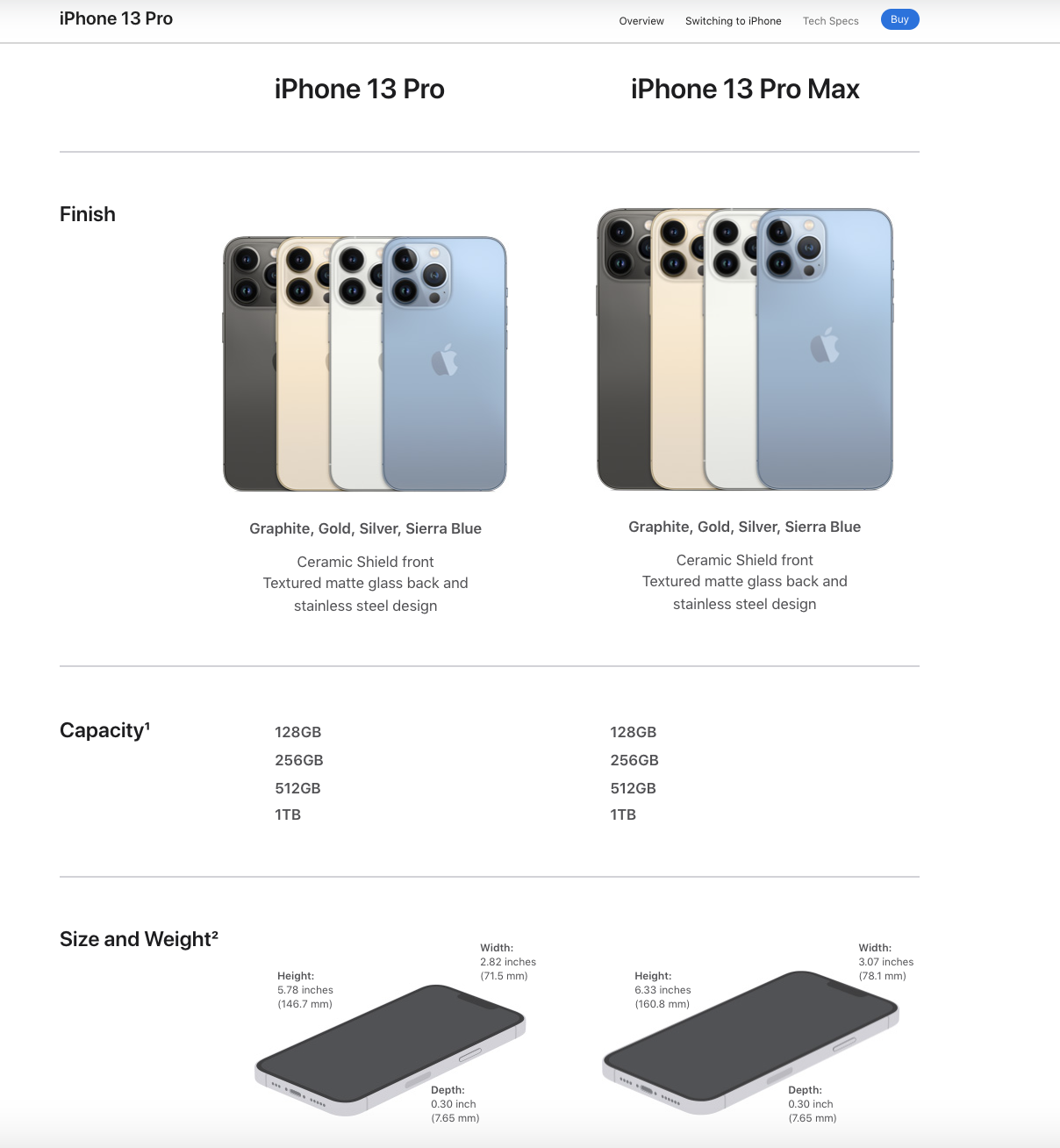
Because the page’s objective is to compare two similar products, it’s formatted as a table, with equivalent information on both sides and plenty of visuals. This way, users can quickly find differences or the details they care about most.
In the same fashion, below is yet another example of very well-structured commercial content for Android phones:
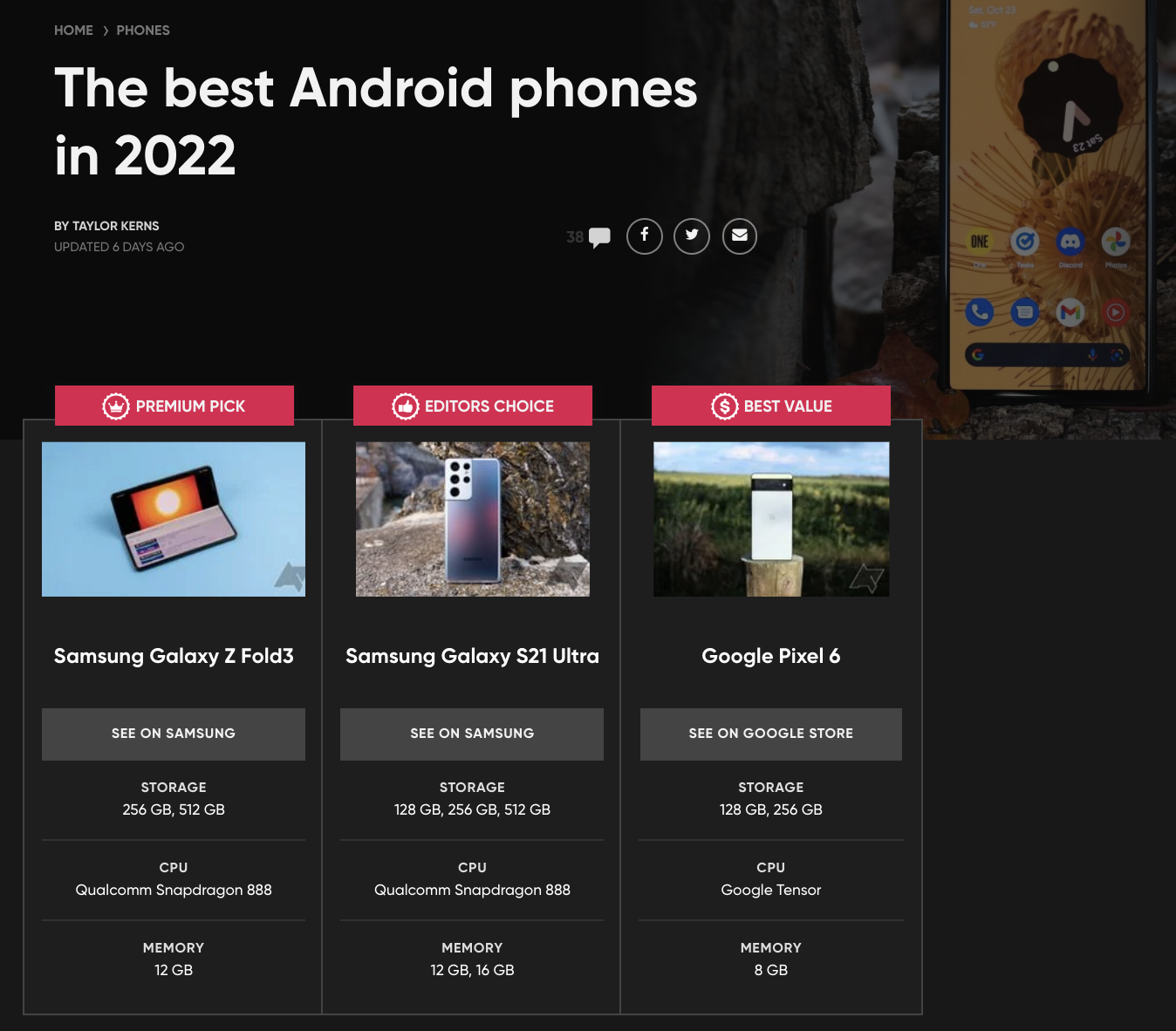
Android Police’s article, “The Best Android Phones in 2022,” opens with a quick snapshot of their conclusion. Realistically, their three top pics are also displayed in a table so users can easily compare relevant information.
Still, the article continues by dedicating a header to each phone as you can see in the illustration shown below:
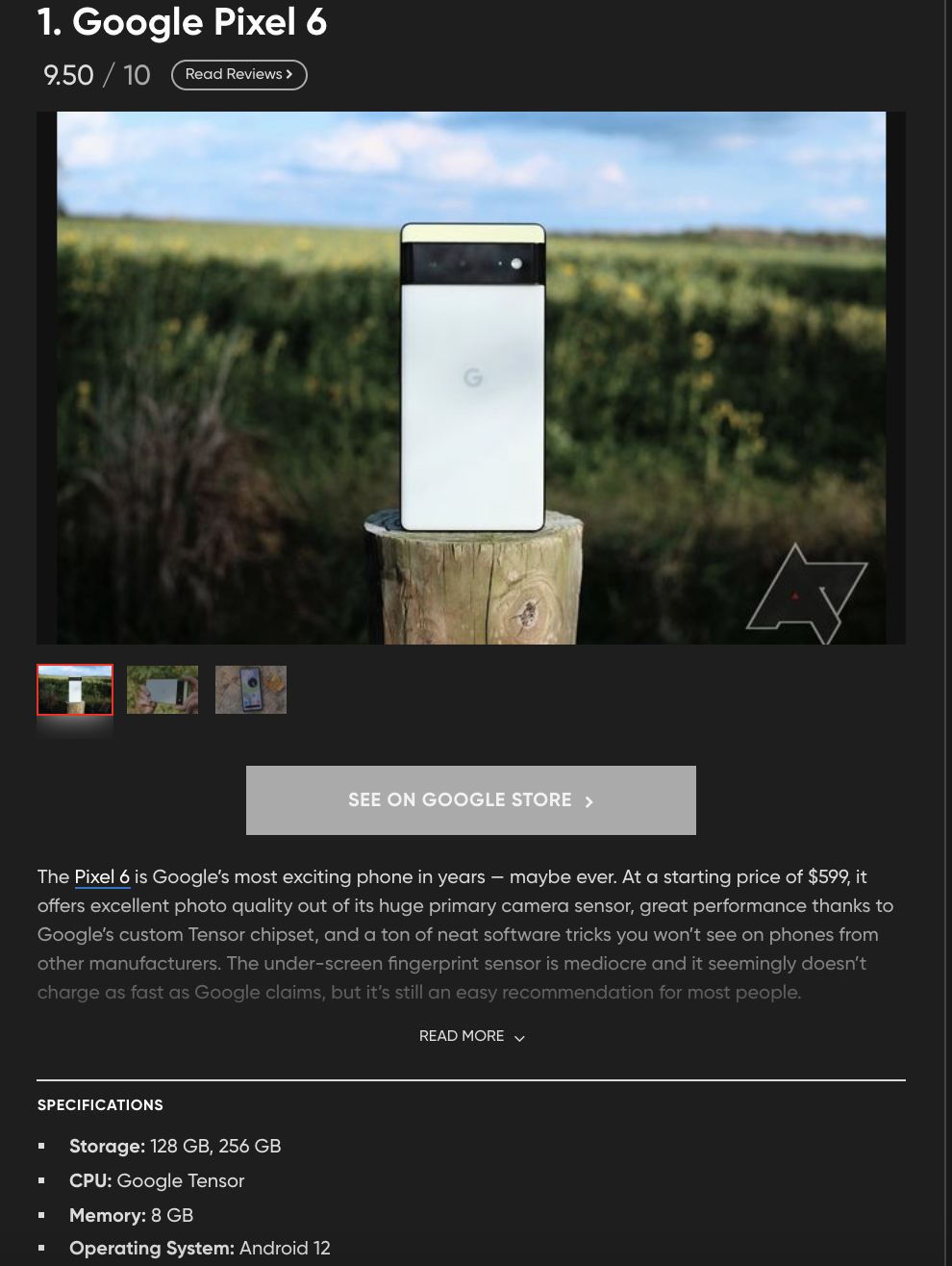
Note how the most important information is the most prominent. The name of the phone, the rating, and a link to reviews are all displayed on top. And then, followed by the technical specifications and other relevant target user details.
Users can also expand if they want to learn more about why the editors came to their conclusion.
4. Make Your Buyer’s Journey Easy
Ask yourself first, what is my audience trying to find on this page? Is the journey easy for them? And then, build a well-structured page with that need in mind. Next, optimize it with descriptive page titles, headers, meta descriptions, and URLs. Also, make it as easy as possible for them to purchase.
Whilst, considering making use of certain end user-based elements a priority. Create links to more information, lead generation forms, purchase pages, etc. In both examples (Apple and Android Police), the commercial content was structured, highly organized, and reader-friendly. Users could educate themselves quickly and make a seamless purchase decision.
Use a similar philosophy for commercial content on your site. Always remember, you want to target commercial keywords. So, you need to know what the user is asking for. Overall, make sure that you structure your website pages well too. So that your target users can find the answer as efficiently as possible.
5. Determine Search Intent From Keywords
Determining search intent is a crucial step in any content strategy. Why? Because, as stated above, search intent often aligns with where users are in the marketing funnel. Below is a list of items with details of how it usually works:
- Awareness: Informational keywords like “how to do keyword research.”
- Consideration: Commercial keywords like “best keyword research products.”
- Conversion: Transactional or navigational keywords (often branded) like “Semrush subscriptions.”
In many cases, you can determine a keyword’s intent based on the keyword itself and its search results. For example, an informational keyword will often use question words or be phrased to indicate what the user is learning. The results might include a snippet answering the user’s question.
Similarly, a commercial transactional keyword is likely to reference a specific product or type of product. These queries might generate a carousel of products, user reviews, or links to retailers. That said, you don’t have to figure it out yourself. Instead, you can use a tool such as Semrush in this case.
The SEMrush tool helps you to find search intent during your keyword research. Using their Keyword Magic Tool, you can even filter by search intent. And then again, target only those that align with your goals.
If you’re researching a single keyword, you can also find this info in Keyword Overview. At the same time, if you’re researching a single keyword, you can also find this info in the SEMrush Keyword Overview Dashboard as shown below:
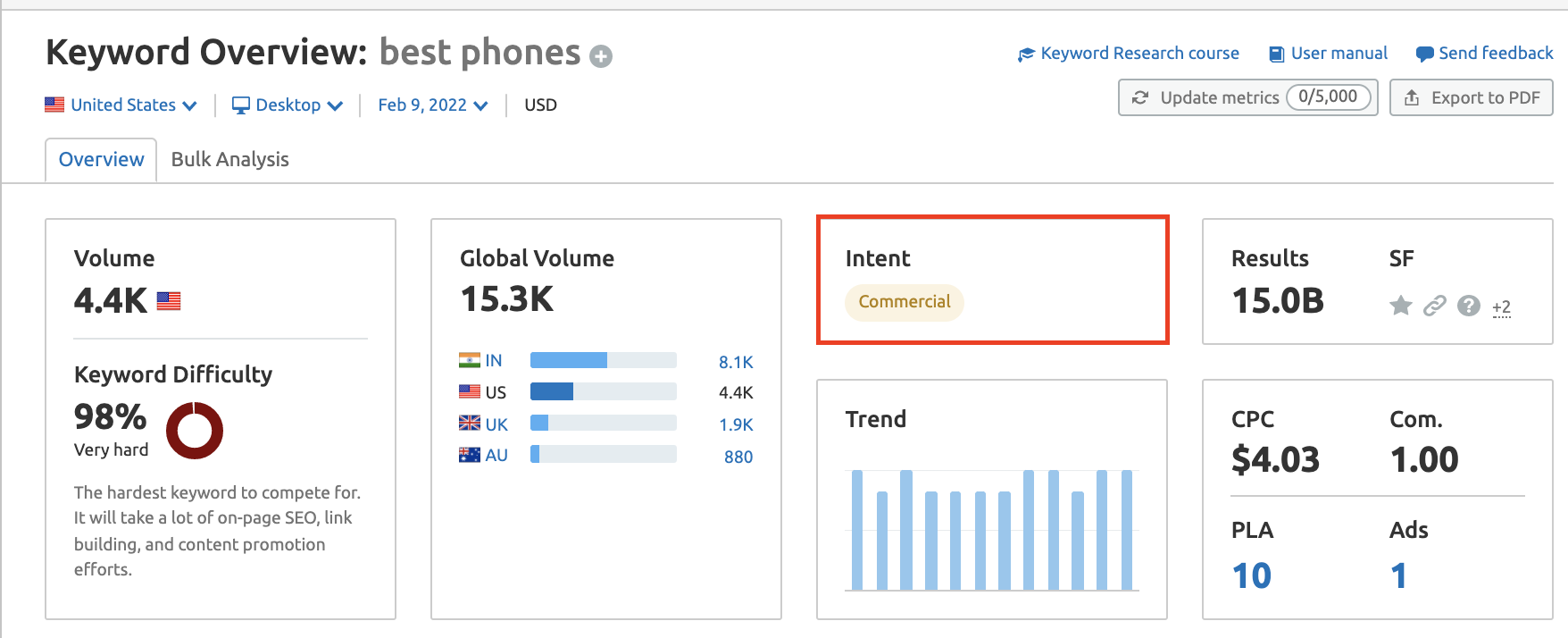
Be that as it may, you can now create a more targeted content strategy to connect with your audience more effectively. As you also rank higher using these insights. Next, analyze your user’s search intent behavior.
And then, start researching for target keywords while building a content strategy that effectively serves your audience.
Final Thoughts:
Ultimately, an effective website provides users with the information they need right when they need it most. Informational content helps users to educate themselves on useful topics to them.
Commercial content helps them make more informed purchase choices. By targeting transactional and navigational keywords, they’ll find you quickly. More so, whenever they’re ready to convert. Knowing the searcher intent behind target keywords can make your search campaign more effective and efficient.
Do you or your team spend a lot of time in spreadsheets? Whilst, manually finding and tagging types of user intent labels to all of your keyword lists? You need to know that manual spreadsheets work no more.
But, worry not! Semrush just released a new search intent filter and added it to all of our award-winning keyword-based reports. This allows you to immediately see the intent (or intents) of any keyword.
Learn More: 7 Tools That New Businesses Can Use To Target The Best Keywords
That’s it! It’s time you research keywords & domains, and track positions. At this time, no other major SEO software offers a solution for search intent optimization every step of the way like Semrush now does.
Similarly, you can now instantly see keywords on Semrush labeled with an intent. Using the Semrush Keyword Magic Tool, you can easily filter entire reports by intent. You now have a clear idea of how to get started with search intent.
Whilst, targeting users per their interests. But, if you’ll need more help, you can Consult Us for more help. Not forgetting, you can also share your additional suggestions, contributions, recommendations, or even questions in our comments section below. You can also Donate to support our Creative Bloggers for the good work they do.
Get Free Updates
Notice: All content on this website including text, graphics, images, and other material is intended for general information only. Thus, this content does not apply to any specific context or condition. It is not a substitute for any licensed professional work. Be that as it may, please feel free to collaborate with us through blog posting or link placement partnership to showcase brand, business, or product.




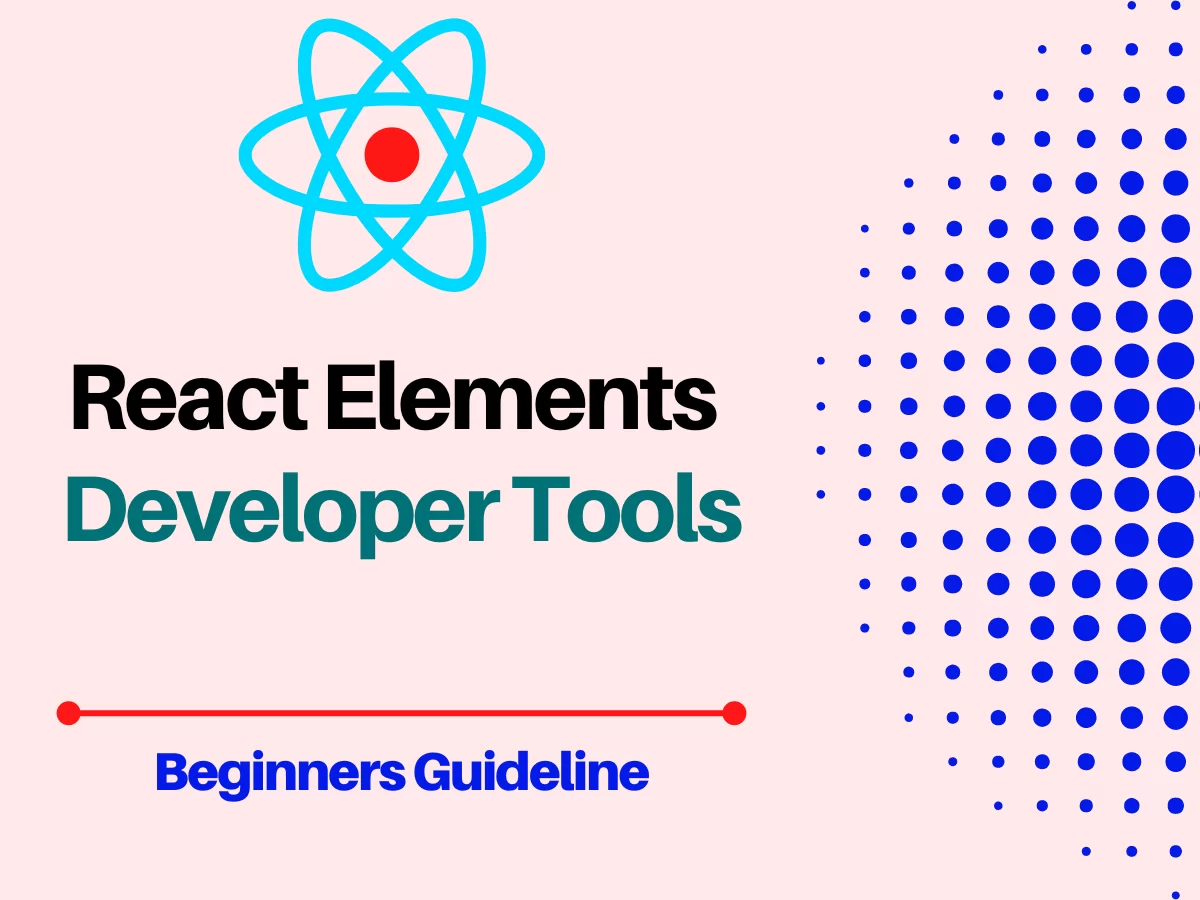
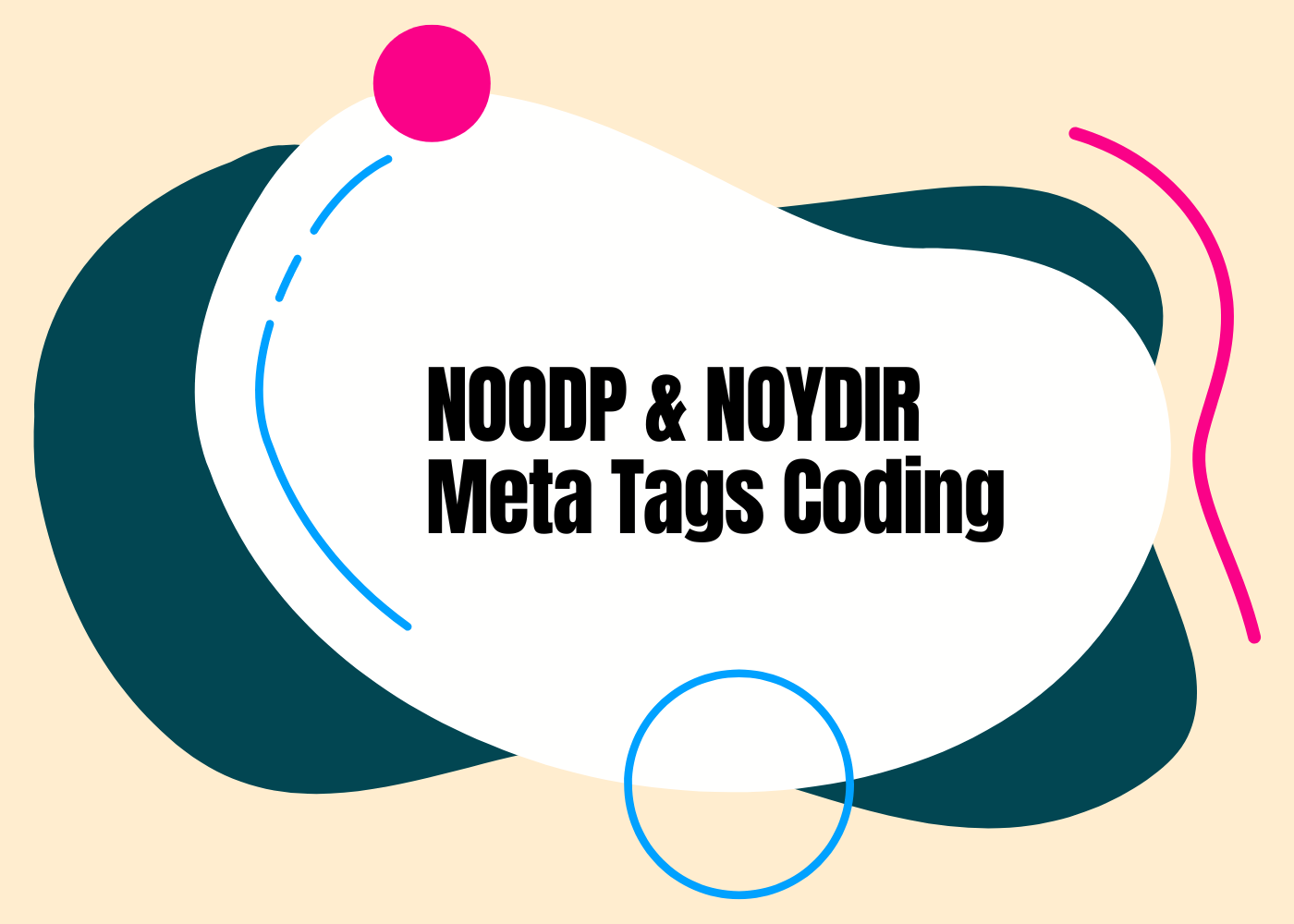

I appreciate your perspective, Amjad. It’s important to consider the different factors that contribute to topic in order to find effective solutions.
I do enjoy the way you have framed this problem and it does offer me a lot of fodder for consideration. Nonetheless, because of what I have observed, I just simply wish when other commentary stack on that people today stay on point and not embark on a tirade involving some other news of the day. Still, thank you for this superb piece and whilst I can not necessarily agree with this in totality, I regard the point of view.
And, we thank you for your time and positive thoughts.
You are free to come back and learn more about our future blog articles with related topics.
I am extremely impressed with your writing skills as well as with the layout on your blog. Is this a paid theme or did you customize it yourself? Anyway keep up the nice quality writing, it is rare to see a great blog like this one today..
We are so glad that you enjoyed reading one of our blog posts and that you find it relevant.
We customized our site from the ground up in order to meet all our reader’s demands and to offer them the best experience.
You are always welcome to come back for more related blog articles and similar topics.
Super-Duper site! I am loving it!! Will be back later to read some more. I am bookmarking your feeds also
Thanks a lot for sharing your positive feedback with us.
We look forward to seeing you in our next blog articles that are even more relevant and resourceful to you.